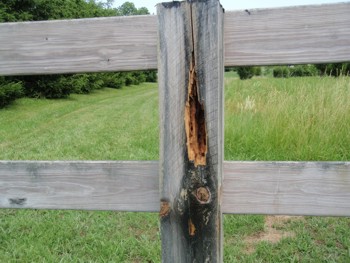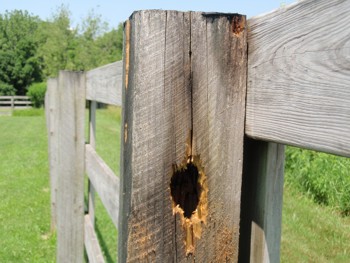Preventing Woodpecker Holes
DEAR TIM: Woodpeckers are systematically destroying some fence posts in my yard. I’m at my wits end trying to figure out how to stop them. Are there chemical sprays I can put on the wood that will repel them? What about decoys or something like a scarecrow? Do you know of anything that will work to stop them from making my fence look like a piece of Swiss cheese? Shirley S., Hamilton, OH
DEAR SHIRLEY: Oh I can absolutely feel your frustration. Woodpeckers used my past house to find their mates by pecking on my aluminum gutters at dawn. Who needs an alarm clock or rooster when you have these hard-headed birds heralding the start of another day?

It's almost impossible to stop woodpeckers from creating holes like this. But there is a way to fool them. PHOTO CREDIT: Shirley Sendelbach
Add to that the fact they used to peck holes in several of the fascia boards around my house just as they’re doing to your fence posts. No matter how hard I tried, I couldn’t get them to stop.
They only stopped when they exhausted the food supply. You see, woodpeckers hammer at trees and other wood primarily for one reason: Food. Hidden just under the surface, woodpeckers can find all sorts of tasty insects including, but not limited to, carpenter ants, carpenter bee larvae, termites, bugs in general, etc.
I’m convinced that woodpeckers can hear or smell the insects. You don’t see woodpeckers in the wild randomly peck at wood that’s not infested with insects. I know as I live near the woods and I see woodpeckers all the time. They don’t bother wood that’s free of insects.
If this assumption is correct, then it becomes somewhat easy to prevent woodpecker holes. You keep the wood you have free from insects by preventing rot and decay. In the case of your fence posts, this means they need to be sealed regularly so that water can’t saturate the wood. Wet wood is very inviting to insects.

PHOTO CREDIT: Shirley Sendelbach
If I were you, I’d remove the damaged fence posts and replace them with wood that you’ve sealed with a semi-transparent water repellant. Be sure you allow the bottom and the top of the post to soak in liquid for an hour or so. This allows the end grain of the wood to soak up as much of the chemical as possible.
Don’t get rid of the damaged fence post. Move it away from the fence to some other part of your yard. Reinstall it in the ground and let the woodpeckers have at it. Make a humorous sign that says: "Woodpeckers and Insects Welcome" and hang this on the post.
The old post will satisfy the hard-coded survival DNA in the woodpeckers as they constantly forage for food. If woodpeckers are attacking your house, then you can try this same strategy using some old log you can find. Bring it home and put it up as a totem pole offering in your backyard. Hopefully the woodpeckers will be attracted to it assuming it’s full of tasty treats.
You may be groaning at the task of replacing your perforated fence post with a new one, especially if the old one is set in concrete. If that’s the case, this will be the last time you’ll struggle with this fence post location.
The trick is to set the new post with just soil or crushed gravel if you feel you need a masonry support collar. Crushed gravel will perform just as good as concrete. The advantage is that it’s so much easier to remove the gravel if you should ever have to replace the fence post in the future.
 If you decide to apply the water repellant to the entire wood fence, you should clean it first. Use oxygen bleach mixed with water for this task. The oxygen bleach will not harm any surrounding vegetation. It will return the wood to it’s original color so the new fence post matches all the other fencing.
If you decide to apply the water repellant to the entire wood fence, you should clean it first. Use oxygen bleach mixed with water for this task. The oxygen bleach will not harm any surrounding vegetation. It will return the wood to it’s original color so the new fence post matches all the other fencing.
The oxygen bleach will remove dirt, mold, algae and sun-damaged wood fibers that are now gray in color. Rinse the clean wood with fresh water and allow it to dry a day before applying the water repellant.
Search online and you’ll discover other ideas to repel woodpeckers. Some are unreasonable and may get you in trouble with your neighbors. Who want’s a neighbor banging pots and pans or letting off fireworks in an attempt to get rid of the birds?
You can try to create large silhouettes of birds of prey that eat woodpeckers. These may work for a while, but don’t underestimate the intelligence of the little devils. When they’re hungry, they’ll soon probably test to see if you handiwork is a real bird.
If you want to attempt to use insecticides to kill the food source, be sure the chemicals are approved and will not hurt the water supply in your area. The last thing you want is to pollute the water and start to grow a tail or a third eyeball.
Column 887